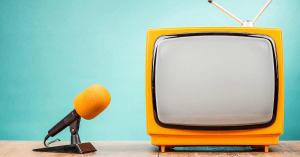Netflix cleaned up last week at the Emmys, getting more nominations than any other new-model streaming service. However, it isn’t all success stories for the digital giant.
Amidst news of their 4.8 billion dollar debt (something that CFO Dan Wells says will likely impact programming decisions in the very near future) and Disney announcing it would soon be pulling its content from the service in favor of starting its own streaming platform, Netflix clearly has some troubled waters ahead.
Videos by PopCulture.com
“Netflix is trying to be everything for everyone, while much of its competition is zeroing in on a more focused goal,” Dan Pappalardo, President of Troika, a brand experience agency with deep roots in TV Network branding (including HBO, Hulu, and Netflix) told PopCulture.com.
This could explain why the streaming giant has been announcing cancellation after cancellation this year, after historically keeping its original programming running longer. But as Pappalardo points out, Netflix’s early model wasn’t necessarily sustainable: “For example, they took a great risk in buying 26 episodes (two seasons) of House of Cards for a reported $100 million with no pilot and the promise of no interference. While that bet paid off, it’s not one you can reliably replicate over and over again,” he says.
Indeed, Netflix’s “be everything for everyone” approach has aligned closely with the introduction of some serious flops. This year’s Gypsy and Disjointed both received scores of 25% or lower on Rotten Tomatoes despite a relatively high calibre of star power attached.
Cancelled shows aren’t necessarily a sign of failure in and of themselves, though. In fact, Netflix CEO Reed Hastings said earlier this year in a CNBC interview that he had been “pushing the content team” to “take more risks” and “try more crazy things”, spinning having a “higher cancel rate overall” as the mark of a studio that’s truly innovating.
That being said, however, these cancellations come at a time when purse strings are sure to be tightening, leaving less room for innovative experimentation and requiring more reliance on what has already been successful for Netflix. The company’s aforementioned debt is a bit of a wake-up call.
As Dan Pappalardo told us, however, the way out for Netflix is through: “Netflix will need to maintain its aggressive growth in their subscription base to stay alive. With 52 million subs domestically and concerns of reaching a saturation point, their future lies in the march to expand internationally,” he said, painting a clear picture of the struggles ahead.
While Netflix’s original programming has already reached some acclaim abroad, historically Netflix’s library varies depending on what country you’re streaming from. Netflix will need to ramp up subscribership outside the U.S. in order to continue to grow at the rate necessary to maintain its ambitious approach to new content.
And then, there’s the Disney debacle. Netflix has historically been a great platform for family entertainment, with a variety of Disney classics available for streaming. But with Disney now pulling its programming in order to start their own platform, this could mean much of the tried-and-true films in Netflix’s catalogues will be disappearing.
“Content is king,” Pappalardo says, and ultimately a streaming service is only as good as what content it can offer. He expects to see more studios pulling their content in favor of developing their own homes for it, following Disney’s lead. This is part of what makes original content so essential for Netflix and other streaming services like Hulu.
“Netflix, and anyone else in the distribution business, is looking to develop ‘owned’ original content, just as content owners are looking to go direct to audiences and fans,” Pappalardo says. And while it used to be beneficial to most networks and cable channels to find greater distribution via Netflix’s model, things have changed now that Netflix has become such a giant. “Today, many networks see Netflix as a threat greater than an asset, as evidenced in the recent announcement by Disney to pull their content.”
Networks, too, may follow suit. CBS has already launched its own pay-to-play streaming platform CBS All-Access, which contains some original content that isn’t seen on TV. Not only does this give them the ability to have their The Good Wife spinoff’s characters drop the F-bomb, but it also creates a space for developing shows that wouldn’t necessarily thrive on the network overall.
As Pappalardo says, one of the benefits that gave HBO a leg up in the past was the ability to create “shows that not everyone will like, but those that do, will LOVE.” It’s likely that that’s exactly what CBS hopes to do with their All-Access series — cater to devoted fans of existing programs (like in the spinoff The Good Fight) to create a more custom experience akin to what HBO already offers.
While it’s clear the streaming landscape is continuing to change rapidly, it’s not entirely clear how Netflix will fare with the coming changes. After the recent awards tally, it’s likely Netflix is feeling the heat from Hulu, as well. Though the underdog streaming service didn’t rack up as many nominations, its original program The Handmaid’s Tale was a runaway hit throughout Emmy night. Netflix, by contrast, didn’t have as clear of a category-dominating series.
Nonetheless, change is in the air.
——-

Want to win a killer Kingsman: The Golden Circle prize pack? 2 lucky winners will get the chance to win some epic Kingsman gear by clicking here or the image above! Also click here to find out when Kingsman: The Golden Circle is playing near you and pre-order your tickets for your local Regal Cinema!
Most Viewed
-

L-R: Todd Lasance as AFP Liaison Officer Sergeant Jim 'JD' Dempsey, Olivia Swann as NCIS Special Agent Captain Michelle Mackey, Sean Sagar as NCIS Special Agent DeShawn Jackson, Tuuli Narkle as AFP Liaison Officer Constable Evie Cooper and William McInnes as Forensic Pathologist Dr. Roy Penrose in NCIS: Sydney episode 9, season 3 streaming on Paramount+, 2025. Photo Credit: Daniel Asher Smith/Paramount+







